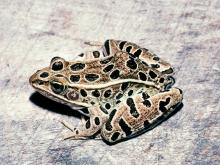Reptiles and Amphibians
Media

Species Types
Scientific Name
Lithobates pipiens
Description
The northern leopard frog is a medium-sized frog with dark spots on the back. Two skin folds run down each side of the back. In Missouri, it only occurs in a few northwestern counties along the Iowa border.
Media

Species Types
Scientific Name
Anaxyrus woodhousii woodhousii
Description
The Rocky Mountain toad has a number of irregular dark brown or black spots on the back and a white belly. It occurs in the Missouri River floodplain, mostly from the central to the far northwestern parts of the state.
Media

Species Types
Scientific Name
Aspidoscelis sexlineata viridis
Description
Prairie racerunners are fast, alert, ground-dwelling lizards. They live in open areas like fields, grasslands, and rocky, south-facing hillsides, including Ozark glades. They are related to the whiptail lizards that live in the western United States.
Media

Species Types
Scientific Name
Plestiodon obsoletus
Description
The Great Plains skink is a large, tan or light brown lizard with most of the scales edged in black, making it look speckled. These markings may form irregular lines along the back and sides. In Missouri, it's found only in our far western and southwestern counties.
See Also
About Reptiles and Amphibians in Missouri
Missouri’s herptiles comprise 43 amphibians and 75 reptiles. Amphibians, including salamanders, toads, and frogs, are vertebrate animals that spend at least part of their life cycle in water. They usually have moist skin, lack scales or claws, and are ectothermal (cold-blooded), so they do not produce their own body heat the way birds and mammals do. Reptiles, including turtles, lizards, and snakes, are also vertebrates, and most are ectothermal, but unlike amphibians, reptiles have dry skin with scales, the ones with legs have claws, and they do not have to live part of their lives in water.





















